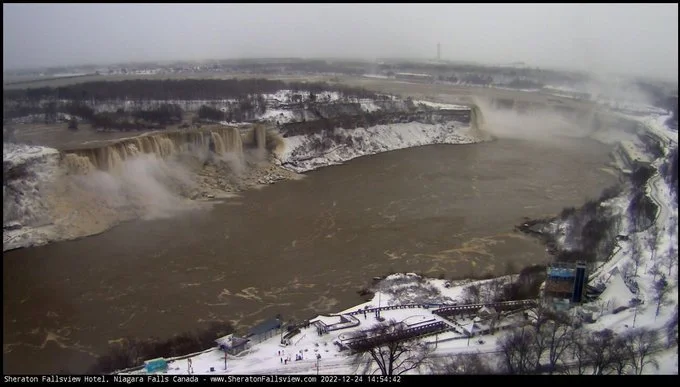A group of women in Pine Grove Correctional Centre are on hunger strike over alleged poor living conditions at the jail. Faith Eagle said she initially began the strike on Oct. 31 as a ceremonial fast for an inmate in the Saskatoon Correctional Centre, who she says can't visit his daughter in hospital. The fast escalated to a hunger strike against poor conditions, she said, including the quality of drinking water.
Niagara Falls turned brown on Christmas Day
Tourists visiting Niagara Falls Christmas Day saw the honourary 8th wonder of the world sporting a new look - the water had turned brown. In a tweet, ECCC Canada said the water looked "chocolate," but you wouldn't want to drink the water roaring down the falls. The temporary makeover was due to winds up to 110 km/h sweeping over Lake Erie for two days prior, coupled with harsh, 9-metre waves that churned debris. So while some of the colour was due to rocks, sand, and other natural pieces of debris some was due to storm sewer backwash emptying into the Niagara River and Fort Erie, Insauga reports.
Why the North Saskatchewan River has gone from brown to blue
The North Saskatchewan River looks less like chocolate milk than usual. The clear, aquamarine waters have revealed hidden sandbars, darting fish, submerged shopping carts — and a flood of questions from Edmontonians seeking clarity on the colour change. The river, which starts at the Saskatchewan Glacier in the Columbia Icefields in Alberta and flows through to central Saskatchewan, is usually a murky brown by the time it reaches Edmonton in summer.
Boil water advisory lifted on Black Lake Denesuline First Nation after more than 7 years
A boil water advisory on the Black Lake Denesuline First Nation that has been in place for more than seven years has been lifted, according to the Government of Canada. The long-term drinking water advisory (LT-DWA) was lifted on January 23. Nearly 200 homes and buildings in the northern First Nation such as the school, fire hall and band office now have clean drinking water from the local water treatment plant.
A Mi’kmaq community’s fears of toxic water recede as Northern Pulp mill winds down
For decades, Pictou Landing First Nation has lived uneasily near an industrial plant emitting brown, foul-smelling waste and the effluent treatment facility they say causes respiratory and skin illnesses. Now, the mill is being mothballed. Ms. Francis, a member of Pictou Landing First Nation, fought for years to stop toxic wastewater from the Northern Pulp plant from being pumped into a tidal estuary next to her community. After decades of court battles, environmental studies and protests, people on the Nova Scotia reserve are hopeful they may one day be able trust their water and land again.
'Truly exciting': Saskatchewan town can drink tap water again after 9 years
Residents of a small Saskatchewan town can drink the water coming out of their taps for the first time in nearly nine years thanks to a new water treatment plant. Craik, population 400, has been facing a boil water advisory since August 2010, when the province found its old plant didn’t meet minimum disinfection standards. “Sometimes it was yellow and sometimes it was brown and sometimes there was dirt in it,” one resident recalled.







